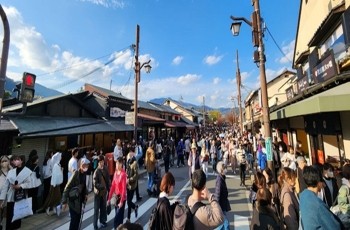シンクタンクからの眼 2024年2月25日
ツーリズムの光と影-魅力を失うリスク The Light and Shadow of Tourism

ツーリズムの光と影-魅力を失うリスク
近年、世界各地の観光地で「オーバーツーリズム(過剰観光)」が深刻な問題となっている。観光客の増加は地域経済を潤す一方で、インフラの逼迫(ひっぱく)、環境破壊、住民の生活の質の低下といった負の側面をもたらすこともある。特に、観光名所として名高い都市や地域では、訪問者数の急増が地域社会に与える影響が顕著になりつつある。
観光地が賑わうことは、一見すると好ましい現象に思える。しかし、観光客の受け入れ容量を超えた場合、その魅力そのものが失われるという逆説的な現象が生じる。例えば、スペインのバルセロナでは、観光客の急増により住宅価格が高騰し、地元住民が市内に住み続けることが難しくなっている。イタリアのヴェネツィアでは、大型クルーズ船が次々と寄港し、観光客の波が押し寄せることで、歴史的な建造物や運河の環境が深刻なダメージを受けている。
また、観光の過密化は、単なる観光名所だけでなく、その周辺地域にも影響を及ぼす。観光客が押し寄せることで、静かな住宅街が混雑し、もともと観光地でなかった場所にも影響が広がることがある。こうした状況が続けば、地域のアイデンティティが損なわれ、結果として観光地としての魅力を長期的に維持することが困難になってしまう。
この問題に対処するために、各国の自治体や観光業界はさまざまな試みを行っている。ひとつの方策として、観光のピークシーズンを分散させる取り組みがある。例えば、フランスのモンサンミッシェルでは、観光客を年間を通じて分散させるための広報活動を強化し、シーズンオフにも訪問者を呼び込む施策を進めている。
また、入場制限や観光税の導入といった対策も有効だ。ヴェネツィアでは、2024年から日帰り観光客を対象とした入場料の徴収を開始し、訪問者数の管理を試みている。これにより、観光客の流入を抑制しつつ、得られた収益を文化財保護やインフラ整備に充てることが可能となる。
行政の取り組みだけでなく、観光客自身の意識改革も求められる。単に「消費する観光」ではなく、訪問先の文化や環境を尊重し、地域住民の生活に配慮した行動を取ることが大切だ。最近では、「責任ある観光(Responsible Tourism)」という考え方が注目されており、環境負荷を抑えつつ地域社会と調和する観光のあり方が模索されている。
観光は、地域経済の発展に大きく貢献する重要な産業である。しかし、行き過ぎた観光が地域の持続可能性を損なうリスクも無視できない。これからの観光業は、訪問者と地域住民が共存できる形を追求し、バランスの取れた発展を目指す必要がある。
(上野あきら、USTC客員教授)
The Light and Shadow of Tourism – The Risk of Losing Its Charm
In recent years, "overtourism" has become a serious issue in tourist destinations worldwide. While an increase in tourists brings economic benefits to local communities, it also leads to negative consequences such as infrastructure strain, environmental destruction, and a decline in the quality of life for residents. This impact is particularly evident in cities and regions renowned for their tourist attractions, where the rapid rise in visitor numbers is placing significant pressure on local societies.
At first glance, bustling tourist destinations may seem like a positive phenomenon. However, when the number of visitors exceeds the capacity a destination can accommodate, a paradoxical situation arises where the very charm of the place is lost. For example, in Barcelona, Spain, the surge in tourism has caused housing prices to skyrocket, making it difficult for local residents to continue living in the city. In Venice, Italy, large cruise ships dock continuously, bringing waves of tourists that severely damage the city's historical buildings and canals.
Overcrowding not only affects major tourist spots but also extends its impact to surrounding areas. As more tourists flood into these destinations, once-quiet residential neighborhoods become congested, and even places that were not originally tourist attractions begin to feel the effects. If this trend continues, the identity of these regions may be eroded, making it increasingly difficult to maintain their appeal as tourist destinations in the long run.
To address this problem, governments and the tourism industry in various countries have been implementing different strategies. One approach is to distribute tourist visits more evenly throughout the year. For instance, in Mont Saint-Michel, France, promotional campaigns have been strengthened to attract visitors year-round, encouraging travel even during the off-season.
Additionally, measures such as entry restrictions and tourism taxes have proven effective. Starting in 2024, Venice has introduced an entrance fee for day-trip tourists to regulate visitor numbers. This initiative aims to curb excessive inflows of tourists while using the revenue generated to fund cultural heritage preservation and infrastructure maintenance.
However, addressing overtourism requires not only governmental efforts but also a shift in tourists' awareness. Rather than simply consuming tourism, travelers should respect local cultures and environments while considering the lives of residents. The concept of "Responsible Tourism" has been gaining attention in recent years, promoting a tourism model that minimizes environmental impact while harmonizing with local communities.
Tourism plays a crucial role in regional economic development. However, excessive tourism also poses risks to the sustainability of local communities. Moving forward, the tourism industry must strive to establish a model in which visitors and local residents can coexist, ensuring a balanced and sustainable future for tourism.
(Akira Ueno, Visiting Professor at USTC)




